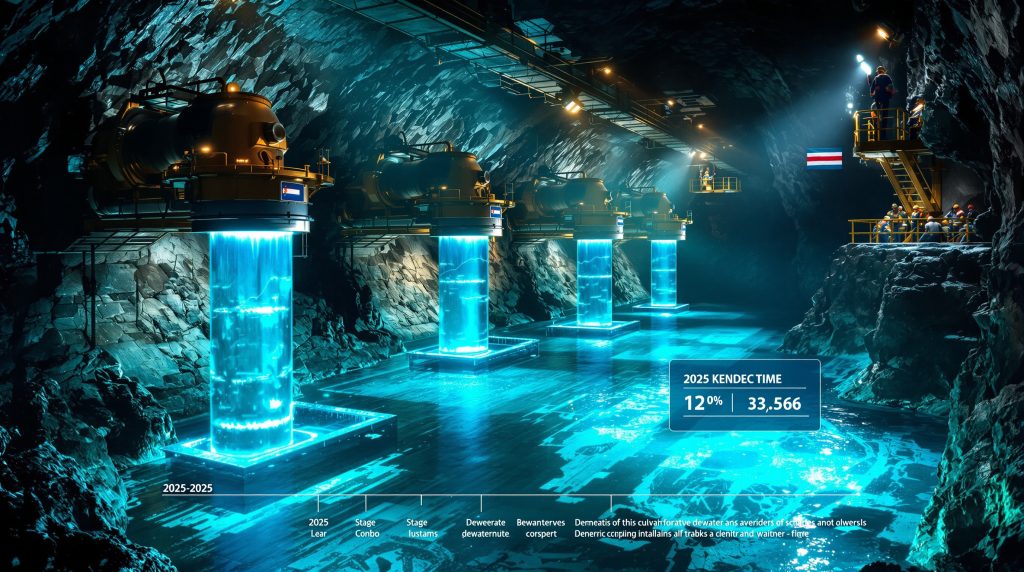Advanced Dewatering Systems at Kakula Mine: Techniques and Impacts
Mine dewatering represents the systematic removal of groundwater and surface water from mining operations to maintain safe and productive working conditions. At underground mines like Kakula, effective water management is essential for ensuring operational continuity, protecting critical infrastructure, and safeguarding worker safety.
The Kakula Mine in the Democratic Republic of Congo (DRC) employs a sophisticated dewatering system to manage significant water volumes following unexpected flooding triggered by seismic activity in May 2025. This comprehensive approach allows for continued access to high-grade copper zones while maintaining operational stability.
Without robust water management systems, underground mining operations face substantial challenges including production delays, equipment damage, compromised mineral recovery, and potential safety hazards that can threaten both personnel and the economic viability of the project.
How Does the Kakula Mine Dewatering System Work?
High-Capacity Submersible Pump Technology
The Kakula Mine dewatering system utilizes cutting-edge submersible pump technology specifically engineered for high-volume water management in challenging mining environments:
- Four massive 4.2 MW submersible pumps installed on the eastern side of the mine
- Each pump measures approximately 12 meters in length with a 1.28-meter diameter
- Individual pumping capacity rated at 650 liters per second per pump
- Combined system capacity exceeding 2,600 liters per second
- Pumps specially designed to handle mining environments with high sediment content
These high-capacity units, supplied by Hefei Hengda Jianghai Pump Co. of China, represent some of the most powerful dewatering equipment deployed in African mining operations. The scale of these pumps demonstrates the significant engineering challenges posed by underground water management at depth.
Power Supply and Infrastructure Requirements
The dewatering operation demands substantial power infrastructure to support continuous operation:
- Dedicated 20 MW generator system powering the pumps
- Independent power supply designed to reduce reliance on the national grid
- Redundant systems to ensure uninterrupted operation
- Specialized electrical infrastructure for underwater deployment
- Advanced monitoring systems for performance optimization and early problem detection
This robust power infrastructure highlights the critical importance of reliable energy supply for maintaining dewatering operations, particularly in regions where grid stability may be inconsistent.
What is the Multi-Stage Approach to Dewatering at Kakula?
Stage One: Initial Water Level Reduction
The first phase of dewatering at Kakula Mine, completed in June 2025, established the foundation for progressive water management:
- Installation of preliminary pumping systems
- Development of water management infrastructure
- Creation of drainage pathways for controlled water flow
- Stabilization of accessible underground areas
- Preparation work for larger-scale dewatering operations in subsequent phases
This initial stage created the necessary conditions for the more intensive dewatering efforts planned for the eastern side of the mine.
Stage Two: High-Volume Eastern Side Dewatering
The current operational phase focuses on aggressive water removal from the eastern section using the high-capacity pump system:
- Two pumps operational by late August 2025
- Two additional pumps scheduled for deployment by mid-September 2025
- Significant water level reduction anticipated by November 2025
- Strategic targeting of access to high-grade copper zones
- Parallel rehabilitation of underground infrastructure alongside pumping operations
This second phase represents the most intensive period of water management, deploying the full capacity of the specialized pumping system to rapidly reduce water levels throughout the eastern mining area.
Stage Three: Deep-Level Access Recovery
Planned for implementation in late 2025, the third stage will focus on deeper mine sections:
- Recommissioning of existing pump stations on the eastern side
- Targeted dewatering of the deepest mine sections
- Establishment of permanent water management systems
- Development of sustainable long-term dewatering infrastructure
- Full restoration of mine access across all operational areas
This comprehensive approach demonstrates the technical complexity involved in managing water inflows in large-scale underground mining operations, particularly following unexpected flooding events.
How Does Dewatering Impact Mine Production and Planning?
Production Recovery Timeline
The dewatering program directly influences Kakula's production schedule and recovery trajectory:
| Timeline | Expected Milestone |
|---|---|
| Late August 2025 | First two pumps operational |
| Mid-September 2025 | All four pumps operational |
| November 2025 | Significant water level reduction achieved |
| Q4 2025 | Resumed mining in western high-grade zones |
| Q1 2026 | Selective mining begins in eastern workings |
| Late 2025 | Stage Three dewatering commences |
This timeline illustrates the direct relationship between dewatering progress and production recovery, with each milestone enabling access to additional mining areas.
Impact on Copper Grades and Production
The May 2025 flooding event significantly affected access to high-grade copper zones throughout the mine:
- Water inundation following seismic activity restricted mining operations
- Production limited to accessible lower-grade areas during dewatering
- Expected grade improvement as dewatering progressively restores access
- Production guidance scheduled for reinstatement in September 2025
- Comprehensive integrated mine plan targeted for release in Q1 2026
The progressive dewatering will enable a methodical return to higher-grade mining areas, directly impacting production volumes and copper grades over the coming quarters.
What Technical Challenges Exist in Mine Dewatering?
Managing Water Quality and Environmental Considerations
Large-scale dewatering operations must address significant water quality concerns:
- Potential contaminants in mine water requiring treatment
- Regulatory requirements for water discharge quality
- Environmental compliance standards and monitoring
- Water quality sampling and testing protocols
- Implementation of sustainable mining transformation
These environmental considerations are essential for responsible mining operations, particularly in environmentally sensitive regions where water resources may be shared with local communities.
Geotechnical Stability During Dewatering
The removal of large water volumes inherently affects ground stability throughout mining operations:
- Changing hydrostatic pressure in surrounding rock formations
- Potential for ground movement, settlement, or subsidence
- Continuous monitoring requirements for tunnel and shaft integrity
- Progressive reinforcement needs during water removal
- Coordinated rehabilitation alongside dewatering activities
The Kakula operation integrates comprehensive rehabilitation of accessible underground areas to maintain structural integrity during the dewatering process, highlighting the interconnected nature of water management and ground control.
How Does Infrastructure Support Successful Dewatering?
Power Generation and Supply Reliability
Reliable power represents a critical factor for continuous dewatering operations:
- The dedicated 20 MW generator system ensures operational continuity
- Parallel refurbishment of Turbine #5 at the 178 MW Inga II hydroelectric facility
- Mechanical installation completed with commissioning activities underway
- Full completion of power infrastructure expected in early Q4 2025
- Strategic reduction in dependence on potentially unstable grid power
This multi-faceted power infrastructure demonstrates the substantial energy requirements for major dewatering operations and the importance of redundant systems for critical mining functions.
Water Management and Pumping Infrastructure
Beyond the pumps themselves, comprehensive water management requires integrated systems:
- Strategically positioned water collection sumps and reservoirs
- Engineered drainage channels and diversion structures
- Heavy-duty pipelines for efficient water transport
- Centralized monitoring and control systems
- Purpose-built discharge and treatment facilities
This integrated approach ensures efficient water removal while maintaining environmental compliance and minimizing operational disruptions throughout the mine.
What Are the Economic Implications of Dewatering Operations?
Cost Considerations for Major Dewatering Projects
Large-scale dewatering represents a significant capital and operational investment:
- Substantial procurement and installation costs for high-capacity pumps
- Extensive power infrastructure and ongoing energy consumption expenses
- Specialized engineering and technical support requirements
- Ongoing operational and maintenance considerations
- Production opportunity costs during implementation phases
These financial considerations must be carefully balanced against the economic value of accessing high-grade ore zones and maintaining long-term mine viability.
Production Recovery and Financial Impact
Successful dewatering directly influences financial performance across the operation:
- Progressive access restoration to higher-grade copper zones
- Improved production volumes and mineral recovery rates
- Reduction in operational constraints and bottlenecks
- Optimization opportunities for the long-term mine plan
- Restoration of production guidance and investor confidence
The company's decision to reinstate production guidance in September 2025 indicates confidence in the dewatering timeline and anticipated effectiveness of the current approach.
How Do Dewatering Systems Evolve with Mine Development?
Adaptive Water Management Strategies
Mine dewatering systems must continuously evolve throughout the mine lifecycle:
- Initial development phase requirements differ from production requirements
- Production phase water management adapts to changing mining fronts
- Ongoing adjustment to varying hydrogeological conditions
- Integration needs for expanding mine workings and depth increases
- Long-term sustainability planning for mine lifecycle management
The three-stage approach at Kakula demonstrates this evolutionary strategy, with each phase building upon and extending previous infrastructure investments.
Technology Integration and Monitoring Systems
Modern dewatering operations increasingly rely on advanced monitoring and control technologies:
- Real-time water level monitoring using pressure transducers and flow meters
- Automated pump control systems with variable frequency drives
- Predictive maintenance technologies to prevent failures
- Integration with data-driven operations
- Remote monitoring capabilities for rapid response to changing conditions
These technological elements support efficient water management while minimizing operational disruptions and optimizing energy consumption throughout the dewatering process.
What Lessons Can Be Learned from the Kakula Dewatering Project?
Risk Management and Contingency Planning
The Kakula experience highlights important risk management considerations for mining operations:
- Seismic activity as a potential trigger for sudden water inundation
- Critical importance of maintaining redundant pumping capacity
- Strategic value of independent and reliable power supplies
- Necessity for rapid response capabilities and emergency protocols
- Integration requirements for dewatering with comprehensive mine planning
These lessons have broader application across the mining industry evolution, particularly for operations in water-rich geological environments or seismically active regions.
Industry Best Practices for Mine Dewatering
The Kakula approach demonstrates several industry best practices for major dewatering operations:
- Phased implementation allowing for adaptive management approaches
- Strategic integration of power infrastructure planning with dewatering needs
- Parallel rehabilitation of affected areas to maintain mine integrity
- Comprehensive monitoring systems for real-time performance assessment
- Transparent communication of progress milestones and production impacts
These practices support efficient water management while maintaining operational continuity where possible and setting realistic expectations for recovery timelines.
FAQs About Mine Dewatering
What causes water accumulation in underground mines?
Underground mines encounter water from multiple sources including:
- Natural groundwater infiltration through rock formations and fracture zones
- Surface water entering through access points during heavy rainfall
- Process water introduced during drilling and mining operations
- Seasonal variations in groundwater table levels affecting inflow rates
- Geological features like faults and fractures that channel water into mine workings
Understanding these sources helps mining engineers develop effective dewatering strategies tailored to specific geological conditions.
How do mines prepare for potential flooding events?
Preparation strategies include:
- Comprehensive hydrogeological studies to understand water patterns
- Installation of early warning monitoring systems for water level changes
- Development of detailed emergency response protocols and procedures
- Maintenance of standby pumping capacity exceeding normal requirements
- Regular training for personnel on water management emergency scenarios
These proactive measures help minimize the impact of unexpected water inflows and accelerate recovery when events occur.
What environmental considerations apply to mine dewatering?
Key environmental factors include:
- Water quality management and treatment before discharge to natural waterways
- Potential impacts on local aquifers and community water resources
- Regulatory compliance requirements for water management
- Implementation of sustainable water use and recycling practices
- Comprehensive monitoring programs to detect environmental changes
Responsible mine operators integrate these considerations into dewatering system design from the beginning of project development.
How does dewatering affect overall mine economics?
Economic impacts include:
- Substantial capital expenditure for pumping systems and water management infrastructure
- Ongoing operational costs including power consumption and maintenance
- Production impacts during implementation phases and water level fluctuations
- Economic value of accessing higher-grade ore zones following dewatering
- Long-term implications for mine sustainability and operational continuity
Effective dewatering systems represent a significant investment that directly enables access to valuable mineral resources that would otherwise remain inaccessible.
What technological innovations are improving mine dewatering?
Recent advancements include:
- Higher efficiency submersible pump designs with improved durability
- Sophisticated automated monitoring and control systems
- Advanced predictive maintenance technologies using vibration analysis
- Energy recovery systems to reduce power consumption
- Water treatment and recycling capabilities that reduce environmental impact
These technological developments continue to improve the efficiency, reliability, and environmental performance of mine dewatering systems worldwide.
Further Exploration
Readers interested in learning more about mining operations in the Democratic Republic of Congo can explore additional educational content about copper mining operations in Central Africa. Industry publications regularly cover developments at major mining projects, providing insights into operational challenges and technical solutions employed throughout the region.
The dewatering systems at Kakula Mine demonstrate the sophisticated engineering approaches required for modern mining operations, particularly when managing unexpected challenges in underground environments. As electrification in mining advances and mine reclamation innovation continues to evolve, water management will remain a critical factor in operational success and environmental responsibility.
Want to Capitalise on the Next Major Mineral Discovery?
Don't miss another transformative discovery like the ones we've seen in copper. Discovery Alert's proprietary Discovery IQ model provides real-time notifications when significant ASX mineral discoveries occur, giving you the edge to act before the broader market. Explore how historic discoveries have generated substantial returns by visiting our dedicated discoveries page.




